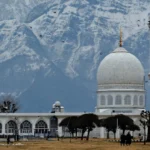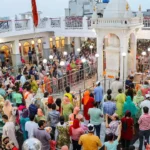Table of Contents
Toggle- Overview
- Historical Significance: Origins of Jamia Masjid Kashmir
- The Unique Architectural Splendor of Jamia Masjid Kashmir
- Role of Jamia Masjid in Kashmiri Society and Religion
- Educational and Social Functions
- Conservation of Kashmir's Craftsmanship
- Challenges and Preservation Efforts
- Future for Jamia Masjid Kashmir
- Conclusion: A Timeless Symbol of Faith and Heritage
- How to book Jamia Masjid Visit online?
- People Also Ask
- What is Jamia Masjid in Kashmir?
- Where is Jamia Masjid located?
- Who built the Jamia Masjid in Kashmir?
- What is the architectural style of Jamia Masjid?
- Why is Jamia Masjid famous?
- What is the history of Jamia Masjid?
- What are the key features of Jamia Masjid’s architecture?
- Can tourists visit Jamia Masjid?
- What is the significance of Jamia Masjid for Muslims in Kashmir?
- What role does Jamia Masjid play in the community?
- How can I reach Jamia Masjid in Srinagar?
- What are the visiting hours for Jamia Masjid?
- What is the role of Jamia Masjid in Islamic education?
- Are there any festivals or events held at Jamia Masjid?
- What makes Jamia Masjid a significant landmark in Srinagar?
- What is the best time to visit Jamia Masjid?
- What is the atmosphere like at Jamia Masjid?
- Is Jamia Masjid open for non-Muslim visitors?
- How has Jamia Masjid been preserved over time?
- What makes the wooden architecture of Jamia Masjid unique?
- What are the nearby attractions to Jamia Masjid in Srinagar?
- How does Jamia Masjid contribute to the cultural heritage of Kashmir?
- Is photography allowed inside Jamia Masjid?
- What are the architectural influences on Jamia Masjid?
- What makes Jamia Masjid an important part of Kashmir’s history?
- Inquiry Form
Overview
Built over the scenery of astounding beauty, high rich culture, and deeper spiritual meaning is some of the world’s most fantastic architectural treasures. Amongst the many historical and religious landmarks in this region, some of them are located in Srinagar. Yet nothing is as unique as Jamia Masjid- a beacon both of religious fervor and of cultural heritage. This magnificent mosque so deeply resides within the spiritual and historical fabric of Kashmir; it speaks for not only architectural brilliance of this region but is also an ardent commitment toward preserving the great traditions of Islam. Jamia Masjid Kashmir is little more than being a house of worship. Instead, it gives voice to the resilience, faith, and the sense of identity of the people of Kashmir.
We will discuss in detail the historical, architectural, cultural, and social significance of Jamia Masjid Kashmir in relation to fully understanding why it remains an important part of the Kashmiri Muslim community. From its inception to its place in modern-day Kashmir, the Jamia Masjid Srinagar is a treasure trove of stories, traditions, and lessons about the region’s past and its present.
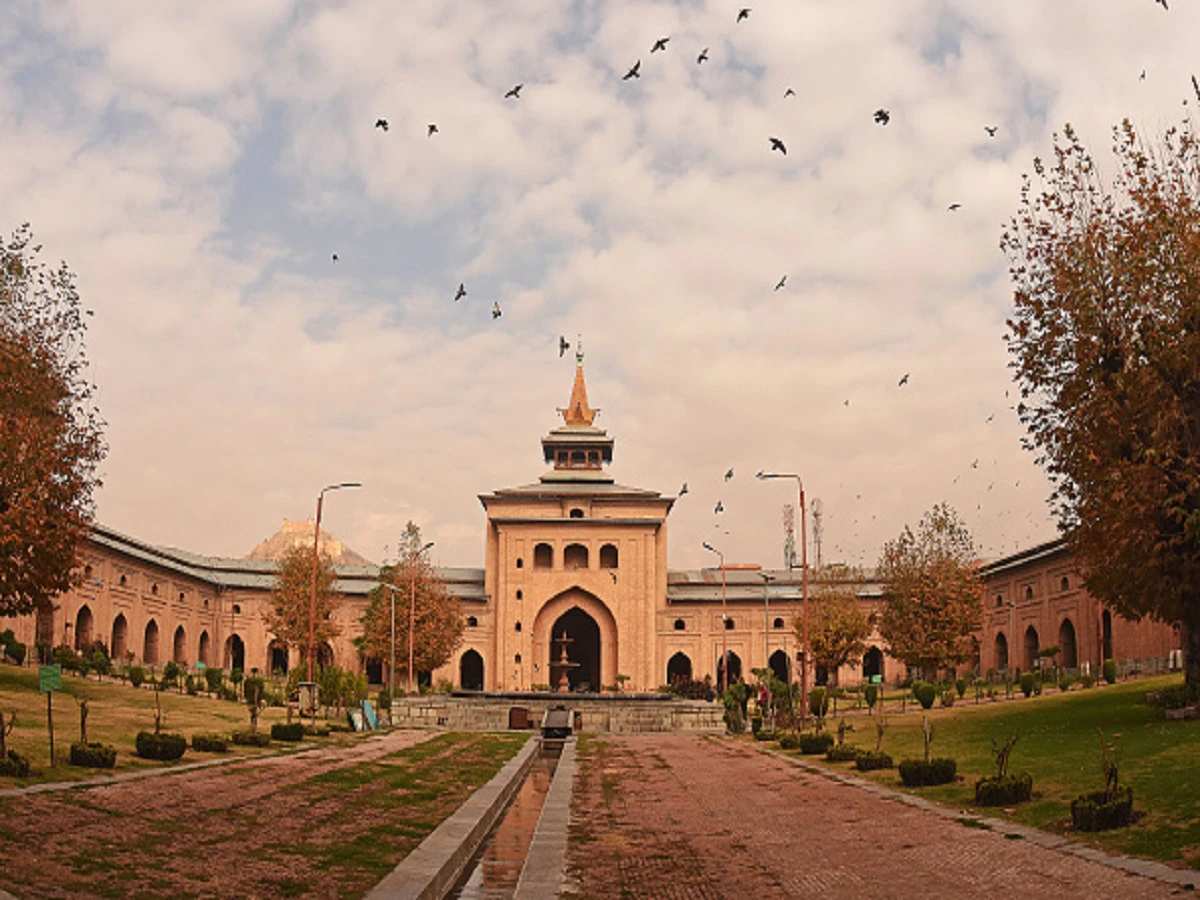
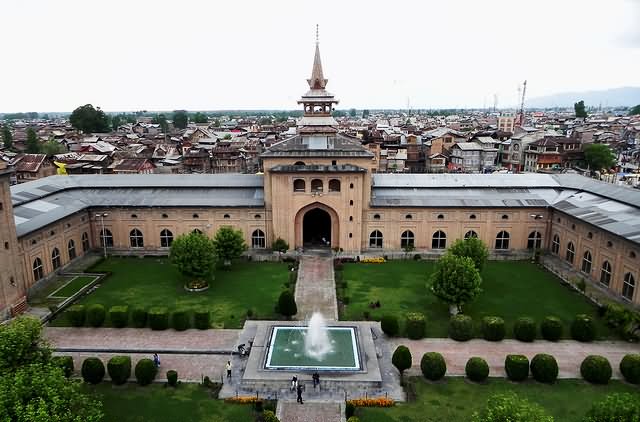
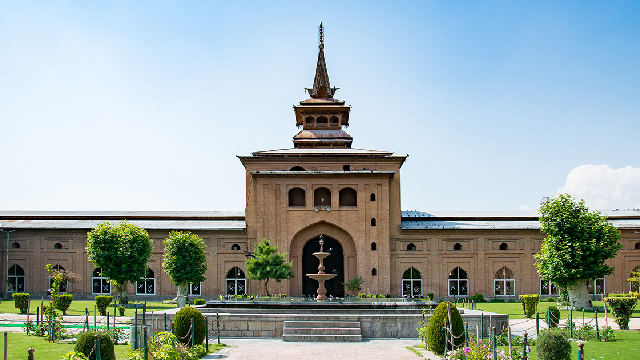
Historical Significance: Origins of Jamia Masjid Kashmir
Jamia Masjid Srinagar is synonymous with the deeply rooted history of Islam in Kashmir. It was conceptualized in the 14th century when there was a heavy invasion of Islam on the region, transforming it fully. Sultan Sikandar has also been famous as Sikandar the Destroyer and, therefore, sometimes associated with the Islamic invasion of Kashmir in the 14th century. His was a middle passage to Kashmir’s religious life. He very religiously espoused Islam, and there developed here a string of great mosques and institutions – Jamia Masjid Kashmir amongst them.
Although its founding date is not quite well-known, this mosque is assumed to have been built in the early 14th century-that is, some 1400 CE. With passing time, this mosque was repaired and reconstructed time and again while still standing testimony to religious and historical relevance of the area. It remains the epitome of undiminished faith while bearing the turmoil and upheavals in Kashmir’s history of turbulent periods of changing political faces.
From the rule of several native kings at the local level to Mughal domination and to the present day when Kashmir is undergoing the convulsions of political turmoil, many of the most historic events have been witnessed and social changes have taken place. All through, Jamia Masjid Srinagar was a guiding beacon for the Muslim community in Kashmir, a symbol of solace and continuity.
The Unique Architectural Splendor of Jamia Masjid Kashmir
The most beautiful one and unique in itself is the architectural style of Jamia Masjid, Srinagar, an amalgamation of Kashmiri and Mughal and Central Asian features. The main material used for the construction of the mosque is wood, an easily available commodity in Kashmir Valley, very durable, and could bear the extreme climatic conditions of the region.
Extremely beautiful Indo-Saracenic, traditional Kashmiri architectural style adorns the construction of this mosque. No one finds beauty in the Deodar wood as this tree is only native to Kashmir. Intricate woodwork, especially in the form of carvings, floral motifs, and geometric patterns, is very characteristic of Kashmiri craftsmanship. This mosque was built by artisans themselves who could work as experts in wood carvings; indeed, even the ornate pillars and ceiling panels, which adorn its inside, are products of their artistic genius.
Wooden Structure
The main feature about Jamia Masjid Kashmir is a wooden base constructed of large wood beams to sustain the roofing and walls. There are lattice-patterned beams as well, meaning that they’re giving strength and an aesthetic beauty. The ceilings bear intricately carvings for natural scenes with flowers, birds, and vines within them, with a calming as well as tranquil effect on the viewer inside.
The Jamia Masjid Srinagar sports the characteristic feature of having a wooden dome, which, being smaller compared to other places, is delicate and unpretentious, because the Kashmiri architectural style embodies subtlety. The four great wooden columns which support this wooden dome bear ornate, geometer floral work that cannot be found in Kashmiri motifs anywhere else in the world.
The mosque has also a prayer hall. It accommodates hundreds of people inside it simultaneously. The prayer niche is intricately designed which guides the congregation to Mecca. The minbar or the pulpit is from where the sermon is delivered by the imam, and that is also art carved intricately with wood. That reflects the talent of the artists of Kashmir.
The Courtyard and Environs
A large courtyard surrounds the mosque, which is one of the salient features of Kashmiri architecture of mosques. The courtyard of Jamia Masjid Srinagar is an open space wherein people gather to pray, celebrate community events, and contemplate in spiritual silence. Around the mosque are arched colonnades, which provide a shelter from the sun and wind. People can quietly sit and talk here.
Jamia Masjid is located on the locality of Nowhatta in Srinagar. This is one of the busier localities in Srinagar, as it houses different cultural and religious landmarks. Markets and a colorful environment characterize this locality; therefore, the mosque is extremely suitable, playing the role of a spiritual oasis for its people amidst the hectic city life.
Role of Jamia Masjid in Kashmiri Society and Religion
The Jamia Masjid Srinagar has always been a significant site in Kashmiri society, for it not only serves as a place of worship but also serves as a hub for community activities, education, and social bonding. It is one of the most important religious institutions in Kashmir, attracting thousands of people every year for daily prayers, religious ceremonies, and cultural events.
A Center for Religious Worship
Being one of the largest mosques in Srinagar, Jamia Masjid Kashmir is the vital center of worship for the local Muslim community. The five obligatory Salat prayers will not pass without accom- modation, but Friday Salat is the most salient where people gather for sermon and prayer. During Ramadan, the masjid presents a massive influx of worshippers coming in for prayer, breaking their fast, and participating in the overall spirit of the holy month.
The mosque conducts the Eid prayers, besides performing special Eid services during Eid-ul-Fitr and Eid-ul-Adha both, where thousands of people visit Jamia Masjid Srinagar to hold their special Eid prayers. Such Eid services indicate the end of the fasting month and complete the obligatory act of sacrifice. The events are a reflection of the integration and cohesion of the Kashmiri Muslim community when all the sections of people come together and enjoy their religion common with brothers and sisters.
Educational and Social Functions
Jamia Masjid Srinagar is not only a place for religious worship but an institution for Islamic learning. The mosque has been known for centuries through its madrasas that impart to young men and women Quranic studies, jurisprudence of Islam, and theology. Through these educational centers, the religion has been passed and preserved so far.
Most of the leading religious scholars, imams, and spiritual leaders of the region have been learned from Jamia Masjid Kashmir. It has helped develop religious leadership in the region and guided the community on matters of faith, social issues, and religious practices.
Besides its religiosity, it is a social landmark center where, besides serving as a podium from which the society can assemble to discuss most of the mishaps that affront them, news, difficulties, and more are shared. Charity galas, blood donation camps, and more for society’s underdogs will not take much time before being announced at Jamia Masjid Kashmir.
Jamia Masjid Srinagar holds greater cultural values aside from the religious ones to the people of Kashmir. It being a symbol for the cultural identity and religious affiliation of the valley reflects on the bond that the valley is so keen in holding between culture and faith.
The architectural elegance and art work of the Jamia Masjid have displayed great mastery of art work of traditional Kashmiri skill passed on the generations of various Kashmiri skilled artisans.
Conservation of Kashmir's Craftsmanship
The Jamia Masjid Kashmir saves the traditional craft of Kashmir within its core. The ancient art of wood carving is well known since centuries long ago in the artisans of Kashmir. Such beautiful carvings done on beams, pillars, and ceilings typify this ancient tradition.
Most of the visitors go to the mosque without speaking words due to excellent detailing and accuracy of woodwork including local craftsmanship.
On the other hand, the Jamia Masjid Srinagar also is a significant institution of Kashmiri culture preservation. It happens to be one place where people gather together in order to share their stories and traditions through the transference of these customs to the younger generation. It happens to be a place that the present and future generations would learn the history and tradition of the Muslim Kashmiri culture.
Challenges and Preservation Efforts
This Jamia Masjid Kashmir, being a historical cultural and religious site, has gone through numerous tests in its long history. Like other ancient buildings of Kashmir, the climatic condition of the place and the unstable political situation in the region have badly affected this mosque. The local authorities and religious bodies look after the mosque these days.
Restoration and Conservation
Efforts have been put to protect the ornate wood carvings and other structural elements to retain the architectural integrity of the mosque. This has been done by applying traditional materials such that the structure of the mosque is preserved in an authentic manner so that its originality is not lost. The historical structure should be conserved, and the region faces a very worst climate. The local craftspeople continue working to maintain it. This way, future generations can enjoy the sight of the beauty and cultural heritage of the mosque.
Future for Jamia Masjid Kashmir
Years will pass, but Jamia Masjid Srinagar would always be a place of significance for the Kashmiri people in their spiritual, cultural, and social life. The legacy of the mosque as a place of worship, learning, and community gathering ensures it will remain the center of the religious landscape in Kashmir for years to come.
Conclusion: A Timeless Symbol of Faith and Heritage
Jamia Masjid Kashmir is truly a living testament to the spirit, strength, and cultural background of the people of Kashmir. It is quite an architectural landmark, but again, it also was a symbol that held the faith and unity within the community from very historical times into this modern age within Kashmir. Its longevity stands as an expression of strong Muslims in the state of Kashmir and their stubborn resolve towards belief and heritage.
In the ever-changing political and social landscape of Kashmir, Jamia Masjid Srinagar will remain a bastion of stability, peace, and spiritual solace. Whether it be a place of prayer, an icon of Kashmiri craftsmanship, or a community gathering center, Jamia Masjid Kashmir will inspire generations to come, standing as a timeless emblem of Kashmir’s deep-rooted Islamic traditions and cultural pride.
How to book Jamia Masjid Visit online?
Contact Brown Chinar at +91 6005039532/+91 9906188874 or Email us at : Enquiry@brownchinarkashmir.com
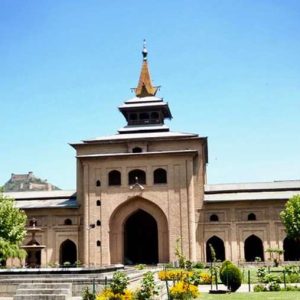
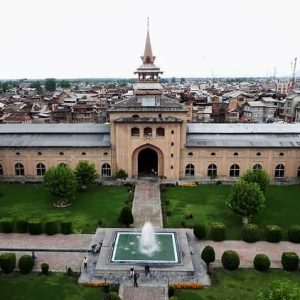
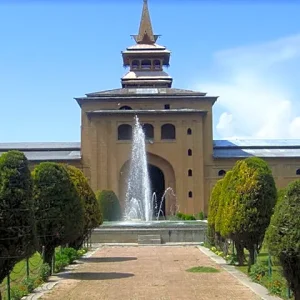
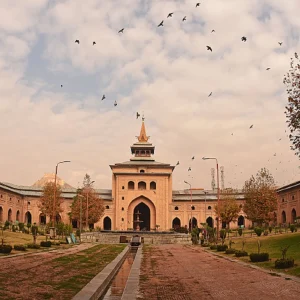
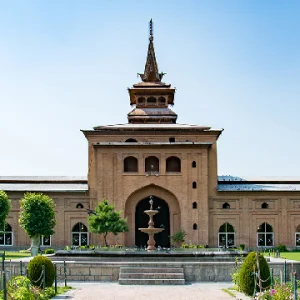
People Also Ask
What is Jamia Masjid in Kashmir?
Jamia Masjid is one of the most prominent and historical mosques in Srinagar, Kashmir. It is known for its exquisite architecture, spiritual significance, and as a center for Islamic education and community gatherings in the region.
Where is Jamia Masjid located?
Jamia Masjid is located in Nowhatta, Srinagar, Jammu & Kashmir, India. It is situated in the heart of the city, making it easily accessible to both locals and tourists.
Who built the Jamia Masjid in Kashmir?
The Jamia Masjid in Srinagar was built by Sultan Haidar Shah in 1400 AD. The mosque was constructed during the rule of the Shah Mir dynasty and is considered a significant historical and architectural structure in Kashmir.
What is the architectural style of Jamia Masjid?
The architectural style of Jamia Masjid is a blend of Indo-Saracenic and Kashmiri wooden architecture. The mosque is made of wood, with intricate carvings and a distinctive pagoda-style roof.
Why is Jamia Masjid famous?
Jamia Masjid is famous for its unique Kashmiri architectural style, its historical significance, and its role as a center of worship and Islamic learning. The mosque has been a focal point for religious gatherings and prayers for centuries.
What is the history of Jamia Masjid?
Jamia Masjid was originally built in the 14th century and has witnessed several renovations. Over the years, it has become a symbol of Kashmir’s Islamic culture and has played a major role in the religious life of the local Muslim community.
What are the key features of Jamia Masjid’s architecture?
Key features of Jamia Masjid’s architecture include the wooden beams, intricately carved pillars, the pagoda-style roof, and large courtyards. The mosque also has decorative calligraphy, wooden lattice work, and traditional Kashmiri motifs.
Can tourists visit Jamia Masjid?
Yes, tourists can visit Jamia Masjid, although they must respect the local customs and religious practices. The mosque remains open for prayers, and visitors can also admire the architecture and historical significance of the place.
What is the significance of Jamia Masjid for Muslims in Kashmir?
For Muslims in Kashmir, Jamia Masjid is a central place of worship, prayer, and community gathering. It holds immense spiritual value and is a symbol of Islamic heritage and identity in the region.
What role does Jamia Masjid play in the community?
Jamia Masjid plays a significant role in the religious, social, and cultural life of the Muslim community in Kashmir. It serves as a hub for prayers, Islamic lectures, community gatherings, and various religious events.
How can I reach Jamia Masjid in Srinagar?
Jamia Masjid is centrally located in Srinagar, and it can be easily accessed via local transportation like taxis, buses, or auto-rickshaws. It is about 3 kilometers from Dal Lake and is located in the bustling Nowhatta area.
What are the visiting hours for Jamia Masjid?
Jamia Masjid is open for prayers throughout the day, with special prayers offered during Fajr, Dhuhr, Asr, Maghrib, and Isha. Tourists and visitors can visit during non-prayer times, though they should be mindful of prayer timings.
What is the role of Jamia Masjid in Islamic education?
In addition to being a place of worship, Jamia Masjid has historically served as an educational institution where Islamic teachings, Quranic studies, and Hadith are taught. It has been an important center for religious education in the region.
Are there any festivals or events held at Jamia Masjid?
Yes, various Islamic festivals and events are celebrated at Jamia Masjid, including Eid-ul-Fitr, Eid-ul-Adha, and the holy month of Ramadan. Special prayers, lectures, and community activities take place during these occasions.
What makes Jamia Masjid a significant landmark in Srinagar?
Jamia Masjid is an iconic structure in Srinagar, both due to its historical importance and its stunning architecture. It represents the religious and cultural identity of Kashmir and stands as a symbol of Islamic unity and faith in the region.
What is the best time to visit Jamia Masjid?
The best time to visit Jamia Masjid is during the day when it is not crowded with worshippers. However, visiting during prayer times can also offer a unique experience, as the mosque fills with devotees, offering a glimpse of the spiritual life in Kashmir.
What is the atmosphere like at Jamia Masjid?
The atmosphere at Jamia Masjid is peaceful, reverent, and serene, with the sounds of prayer echoing throughout the structure. Visitors can enjoy the calmness of the mosque while admiring the architecture and learning about the region’s rich Islamic history.
Is Jamia Masjid open for non-Muslim visitors?
Yes, Jamia Masjid is open to non-Muslim visitors, but they are requested to dress modestly and maintain decorum while inside the mosque. Visitors should also be respectful of the ongoing prayers and religious practices.
How has Jamia Masjid been preserved over time?
Jamia Masjid has been preserved through various restoration efforts, especially after damage caused by natural calamities and political unrest. Its wooden structure, carved beams, and intricate details have been maintained with care to retain its original charm.
What makes the wooden architecture of Jamia Masjid unique?
The wooden architecture of Jamia Masjid is unique because it follows traditional Kashmiri craftsmanship. The use of wood, instead of stone, and the detailed carvings and motifs set it apart from many other mosques around the world.
What are the nearby attractions to Jamia Masjid in Srinagar?
Nearby attractions to Jamia Masjid include Dal Lake, Mughal Gardens, Shankaracharya Temple, and Hazratbal Shrine. Visitors to the mosque can explore the surrounding historical and cultural sites as part of their trip to Srinagar.
How does Jamia Masjid contribute to the cultural heritage of Kashmir?
Jamia Masjid contributes to the cultural heritage of Kashmir by showcasing traditional Kashmiri architecture and by serving as a center for religious and cultural activities. The mosque has been an integral part of the region’s Islamic and cultural history.
Is photography allowed inside Jamia Masjid?
Photography is generally not allowed inside Jamia Masjid, as it is a religious place of worship. Visitors should always seek permission before taking any photographs to ensure they are not disrupting the prayers or services.
What are the architectural influences on Jamia Masjid?
Jamia Masjid’s architecture reflects a blend of Central Asian, Persian, and Kashmiri influences. The intricate wooden carvings, pagoda-style roof, and ornate prayer hall are prime examples of these cross-cultural influences.
What makes Jamia Masjid an important part of Kashmir’s history?
Jamia Masjid is an important part of Kashmir’s history as it has stood for centuries as a place of spiritual significance. It symbolizes the region’s Islamic heritage and has witnessed many historical events, making it a central landmark in the city of Srinagar.

